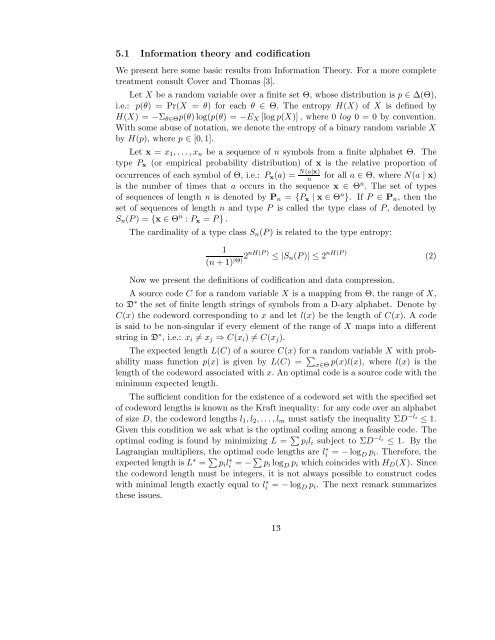CODIFICATION SCHEMES AND FINITE AUTOMATA ... - Ivie
Create successful ePaper yourself
Turn your PDF publications into a flip-book with our unique Google optimized e-Paper software.
5.1 Information theory and codification<br />
We present here some basic results from Information Theory. For a more complete<br />
treatment consult Cover and Thomas [3].<br />
Let X be a random variable over a finite set Θ, whose distribution is p ∈ ∆(Θ),<br />
i.e.: p(θ) = Pr(X = θ) for each θ ∈ Θ. The entropy H(X) of X is defined by<br />
H(X) = −Σ θ∈Θ p(θ)log(p(θ) = −E X [log p(X)] , where 0 log 0 = 0 by convention.<br />
With some abuse of notation, we denote the entropy of a binary random variable X<br />
by H(p), where p ∈ [0,1].<br />
Let x = x 1 ,... ,x n be a sequence of n symbols from a finite alphabet Θ. The<br />
type P x (or empirical probability distribution) of x is the relative proportion of<br />
occurrences of each symbol of Θ, i.e.: P x (a) = N(a|x)<br />
n<br />
for all a ∈ Θ, where N(a | x)<br />
is the number of times that a occurs in the sequence x ∈ Θ n . The set of types<br />
of sequences of length n is denoted by P n = {P x | x ∈ Θ n }. If P ∈ P n , then the<br />
set of sequences of length n and type P is called the type class of P, denoted by<br />
S n (P) = {x ∈ Θ n : P x = P } .<br />
The cardinality of a type class S n (P) is related to the type entropy:<br />
1<br />
(n + 1) |Θ|2nH(P) ≤ |S n (P)| ≤ 2 nH(P) (2)<br />
Now we present the definitions of codification and data compression.<br />
A source code C for a random variable X is a mapping from Θ, the range of X,<br />
to D ∗ the set of finite length strings of symbols from a D-ary alphabet. Denote by<br />
C(x) the codeword corresponding to x and let l(x) be the length of C(x). A code<br />
is said to be non-singular if every element of the range of X maps into a different<br />
string in D ∗ , i.e.: x i ≠ x j ⇒ C(x i ) ≠ C(x j ).<br />
The expected length L(C) of a source C(x) for a random variable X with probability<br />
mass function p(x) is given by L(C) = ∑ x∈Θ p(x)l(x), where l(x) is the<br />
length of the codeword associated with x. An optimal code is a source code with the<br />
minimum expected length.<br />
The sufficient condition for the existence of a codeword set with the specified set<br />
of codeword lengths is known as the Kraft inequality: for any code over an alphabet<br />
of size D, the codeword lengths l 1 ,l 2 ,...,l m must satisfy the inequality ΣD −l i<br />
≤ 1.<br />
Given this condition we ask what is the optimal coding among a feasible code. The<br />
optimal coding is found by minimizing L = ∑ p i l i subject to ΣD −l i<br />
≤ 1. By the<br />
Lagrangian multipliers, the optimal code lengths are l ∗ i = − log D p i . Therefore, the<br />
expected length is L ∗ = ∑ p i l ∗ i = − ∑ p i log D p i which coincides with H D (X). Since<br />
the codeword length must be integers, it is not always possible to construct codes<br />
with minimal length exactly equal to l ∗ i = − log D p i . The next remark summarizes<br />
these issues.<br />
12

















